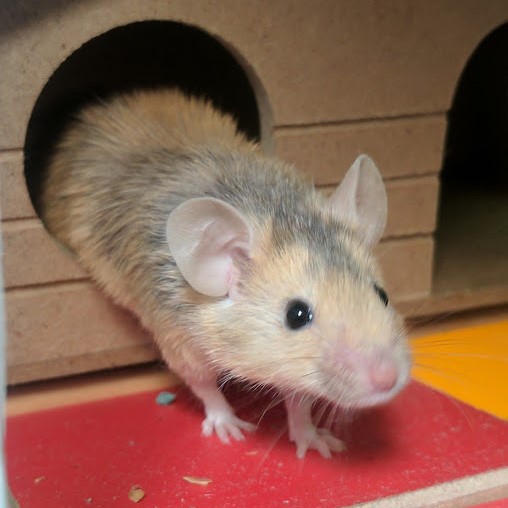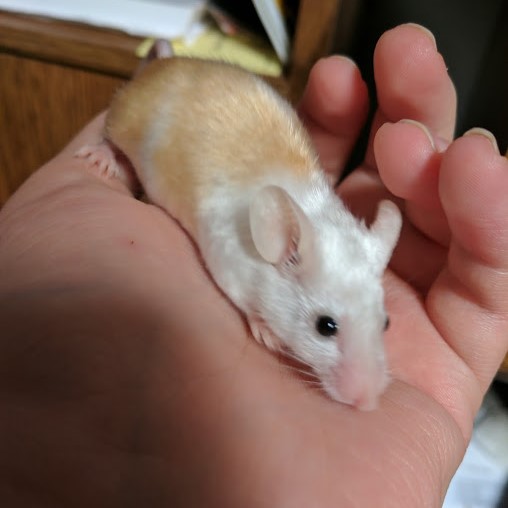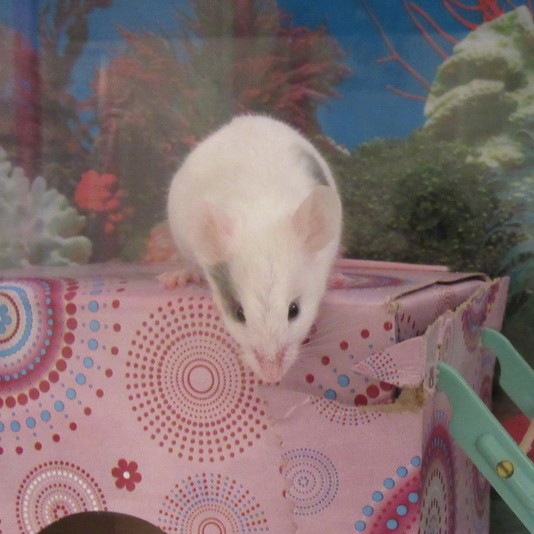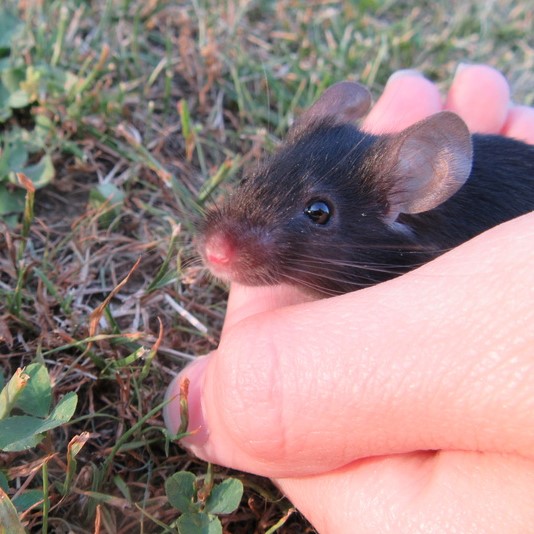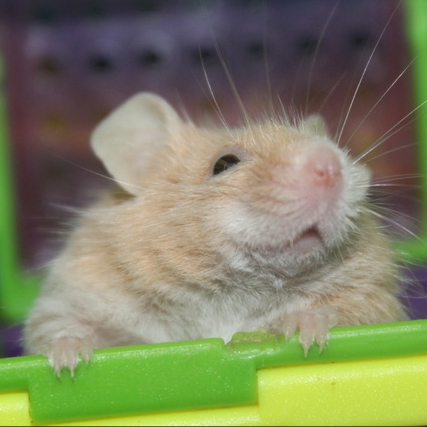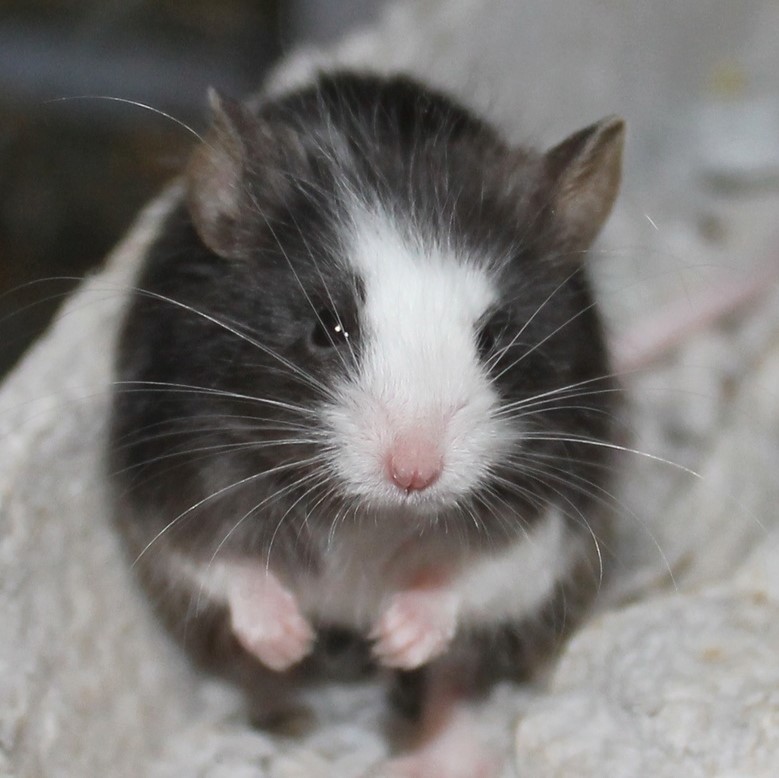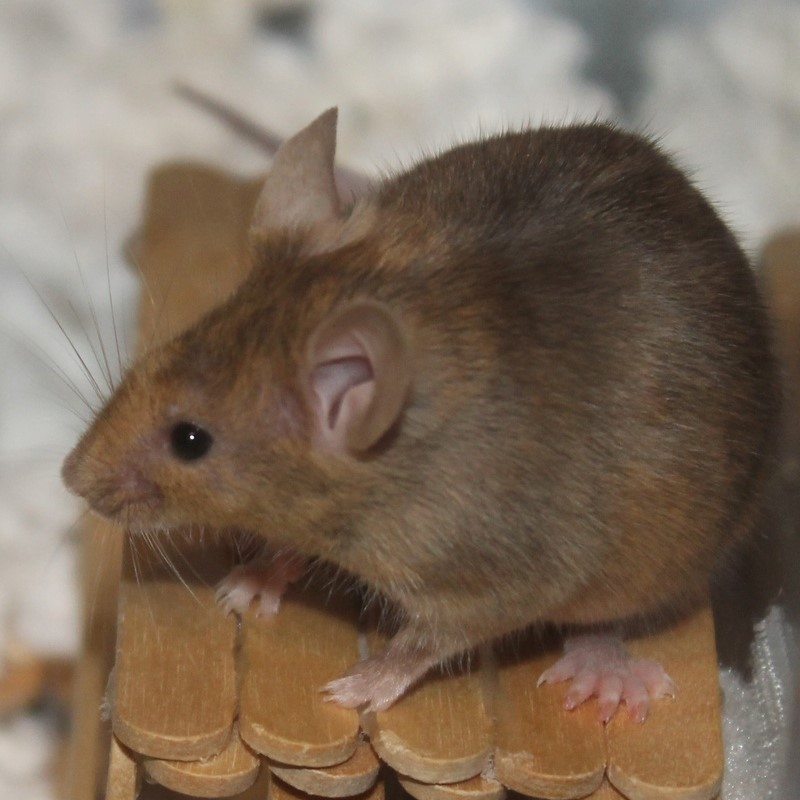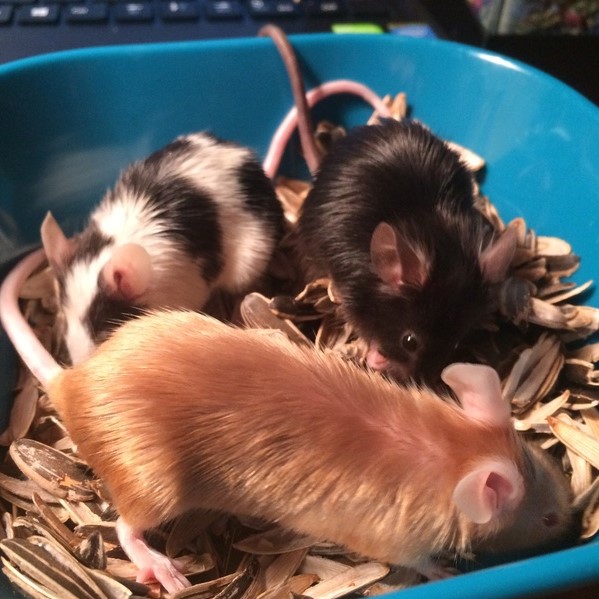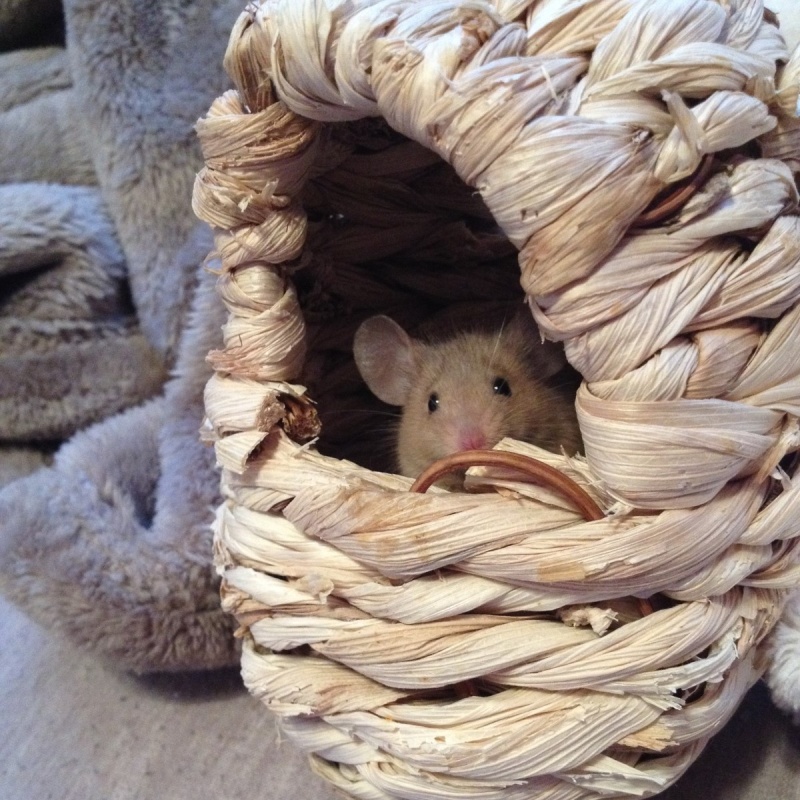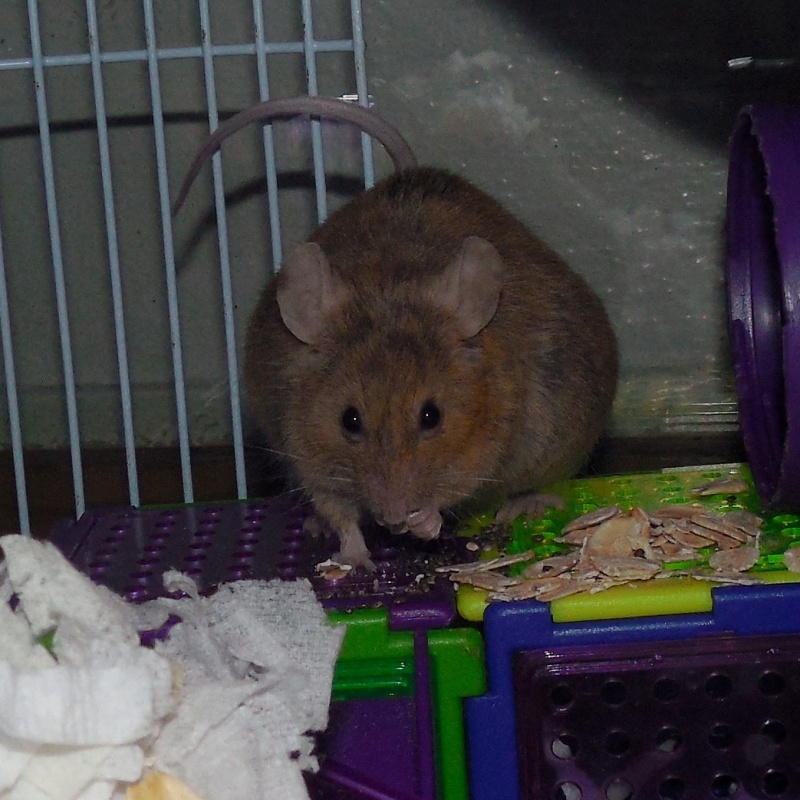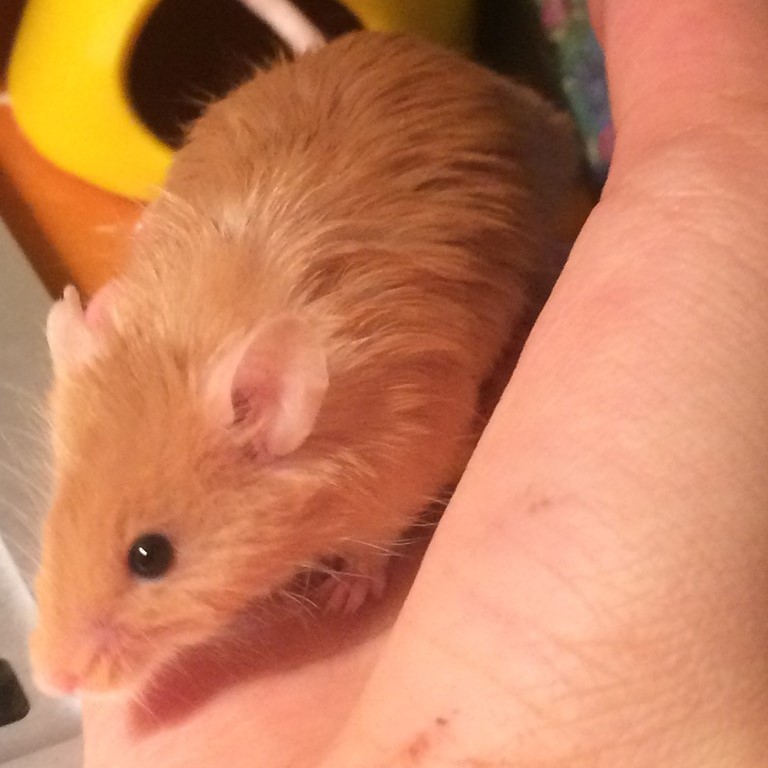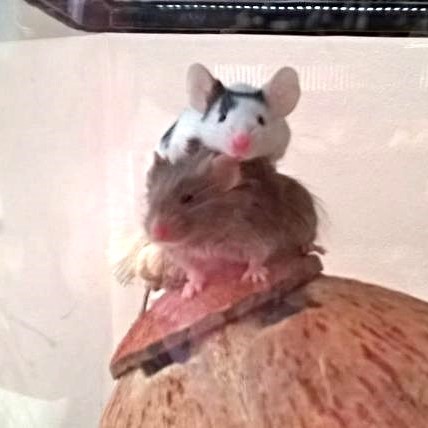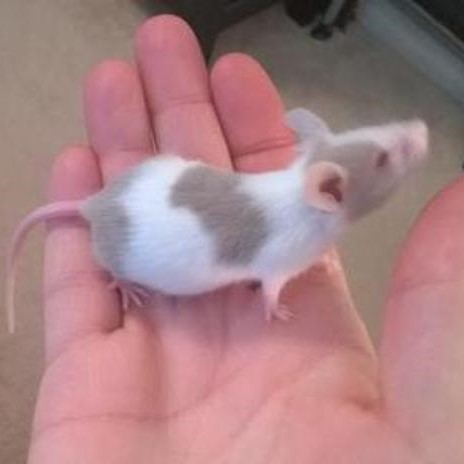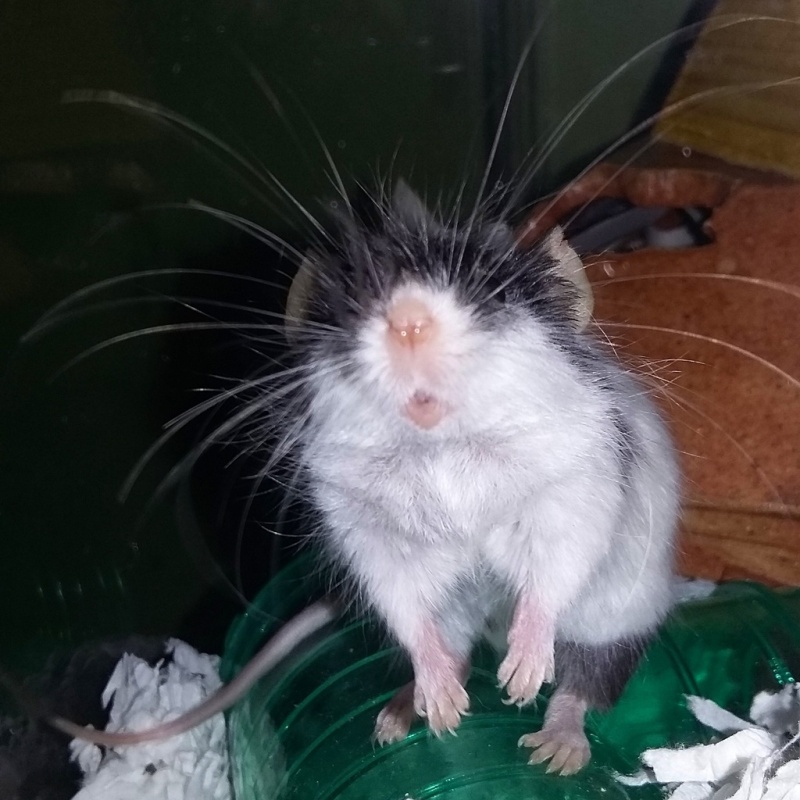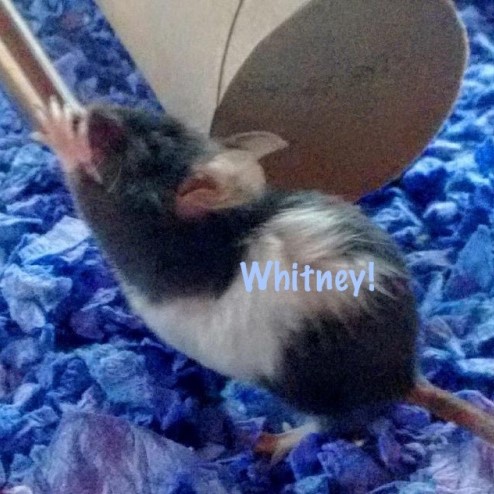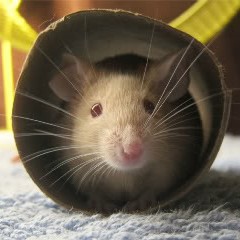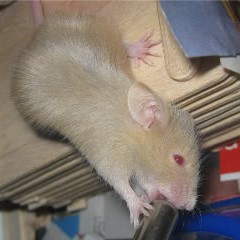Breeding Packet
2 posters
Page 1 of 1
 Breeding Packet
Breeding Packet
| The content on this page was first published on The Fun Mouse website and has been reposted with permission. Please do not reproduce in any way. |
Introduction
If you haven't done so yet, please read the following links:-So You Think You Want to Start a Mousery...
-Breeding Pet Store Mice? There's only one way.
By no means does the following information cover everything you should know before breeding. It is set forth as an outline for those that have been thrown into breeding by means such as pet shop "accidents" and things of the like. Should you intend to become a breeder, you will need to know far more than the basics here.
In this thread you'll find the following:
- Breeding Ethics
Things you need to consider and evaluate before you decide to breed. - Breeding Mice: Mating to Birth
Information about optimal breeding age, number of litters, mating, conception, pregnancy, diet for pregnant and nursing mothers, and housing mothers together. - Caring for Babies: Birth through Weaning
Information about birth, postpartum estrus, birthing complications, runts, handling babies, cleaning the nursery, weaning, and separation. - Caring for Orphaned Mice
Read about fostering orphans to another mother, and how to hand raise them if fostering isn't an option. - Housing for Mothers with Babies
Information about nursery tanks, food and water, nest boxes, nesting material, toys, and an example. - Maternity Nannies
Information about using a nanny and how to pick a good one. - Day by Day Pictures of Baby Mice
Daily pictures of mouse babies from a couple hours old until weaning age (4 weeks). Shows size development in comparison to a quarter.
Breeding Ethics
Before you decide to breed any mouse, there are a lot of things you need to evaluate. Not every mouse is meant to be bred, and not every person is cut out to breed. You must consider many things BEFORE breeding. I realize that this page is long. If you are unwilling to take the time to read through this page and ponder every question seriously, then you should not be breeding.Everything stated here is of equal importance.
Time
Before breeding, evaluate your schedule. Make sure you have time to set aside for your mice every day. You need to factor in possible changes in your life that might take up your time, such a move, a vacation, a new addition to the family, etc. Having time to check on, care for, and handle your mice every day is important for two main reasons: socializing and getting to know their personalities.It is very important to socialize mice so they are well adjusted and tame. Mice need this care, it is not something you can compromise on. Baby mice should be held at least twice a day. If you choose to have more than one litter at a time, you need to factor that into your schedule as well... more litters equals more time.
In addition to taming, it is very important to know each baby individually. This is of extreme importance so that you will be able to observe personality changes that might indicate a health problem. In addition, you will not be able to place your babies properly in the right homes if you don't know their personality. If you don't know their individual personalities, you will not know if they are good for breeders, pets, etc.
If you decide that you have time to breed, make sure that you only have as many litters as you can handle. Mass produced mice are not going to be tame, will have increased risks of undetected health problems, and will not be wanted by pet owners or breeders.
Veterinary Care
Vet care is a must for *any* animal, including mice. All life is valuable and deserves proper care, no matter the size or the initial cost of purchase. Do you have a vet that will see pocket pets? Many vets are not able to see pocket pets for an array of reasons. Some vets don't even have the proper equipment to care for them if needed. You *must* have an adequate vet *before* breeding mice. If an emergency happens, you can't waste time tracking down a vet. If your mice have a life and death situation, time is not on your side. Your mice could die in the time it takes you to search phone books and online. In addition, your vet should be able to handle emergencies. Most birthing complications happen at night when vets are closed. Your vet needs to be able to come in at any time to treat your mice.Finances
Do you have an adequate emergency fund for your mice? Even under the best of circumstances, mice cost money. If something goes wrong, you will need an emergency fund to cover expenses. Complications can't be predicted, but having funds set aside for them can help if such a case arises. At a minimum, I keep $1000 in a fund for my mice. There was a time that I had a very serious emergency and had to dump well over that $1000 into my mice over a 2 month period. My emergency wasn't uncommon and wasn't predictable. While I was dealing with around 120 mice at the time, the financial end of things can add up fast with even one litter of up to 25 mice.You also need to have funds set aside to buy more housing or have housing on hand before breeding. Bucks usually need to be kept alone. 100% male litters *do* happen! Even if you have homes lined up before breeding, consider the fact that something could go wrong and you might need to house them for longer than anticipated. Do you have enough set aside to cover costs of 25 extra boy mice per litter? This not only includes housing but also food, toys, vet care, etc. The expenses for these can add up fast! Always remember that even the best-made plans can go awry.
Adopting out
Do you have secure and adequate homes for any mice you produce? You need to have this *before* breeding. You need to plan on having an all buck litter as they are usually harder to place and they *do* happen! You also need to take into consideration that people back out of adoptions, so you need to have *more* homes than possible mice. People back out of adoptions for an array of reasons. Some can happen innocently enough. Sometimes "life" just happens. Things come up that they can't foresee or prevent. In these cases, you need a backup plan.If your backup plan is a pet shop, consider the fact that the babies are likely to go as feeders. Are you willing to allow your babies to be placed in a tank with a predator, scared out of their minds for who knows how many days, and then crushed to death at the jaws (or body) of their predator? Are you actually willing to let the babies you cared so much for meet their fate like that? On a rare occasion, a pet-only pet shop can be found. However, you will not know where your babies are going. What if they get adopted to someone that looses interest in them? What if they stop caring for the mouse/mice and they die a horrible death? Are you willing to live with the fact that your babies could be neglected or abused? Since you don't know where they are going, this can easily happen. Because mice don't cost much at all, they are more likely to be neglected and/or abused by a pet shop purchaser. Can you really place your babies in a pet shop with such great potential for placing your mice in harm's way? Also, if you adopt out to a pet shop, there is no way to track your babies and any health issues that may arise. If you can't track all babies in your lines, you can't ensure that you are breeding healthy mice.
Stability
Are you stable financially, emotionally, physically, etc? You need stability in every aspect before breeding mice. You can't responsibly bring mice into this world if you are not stable in every way possible. If you're not, it's not fair to these little lives you might be bringing into the world. Mice cost money, and income security/stability is of great importance, as discussed before. In addition to that, you must live in a place that is secure and allows mice. If you are forced to move for unforeseen reasons, where will your mice go? If you have a landlord or live with someone else, are they perfectly content with your mice having babies? You need a stable income, housing, and support of people living in your household before getting pets, let alone having mouse babies.Breeding mice can also be extremely hard on your emotions. There are so many things that can go wrong and break your heart. Are you emotionally stable enough to handle it? Most breeders don't talk much about all the tears and heartache they go through. If you don't think it's emotionally trying, think again. Are you willing to deal with the loss of life? What if the mother has complications and you watch her die a painful death? Can you handle it? What if the mother culls her litter? Can you handle seeing babies ripped to shreds? Sometimes this is even seen happening. You might see a baby being ripped apart and hear it screaming in pain. Can you handle seeing this? Can you understand that this is not a case of the mother being rotten? Mothers have reasons for doing things like this and you can't blame her or be mad at her for doing so. Are you prepared to deal with a loss of entire litters? Are you prepared to deal with a loss of a mother? If the mother is lost yet the babies remain, what are your plans for these live babies? Imagine yourself in every situation possible. Sometimes mice get ill and a breeder will do everything in their power to save them. Some breeders will take on hand raising babies which creates an incredible bond between mouse and human. Even with the best care, most dedication, and doing everything right, animals are lost and the devastation can be excruciating to take. Imagine how much a breeder can bond with their mice and how it can feel to lose a mouse or mice they have put so much care into. Can you deal with the devastation that does happen, at one time or another, with breeding mice?
Taking care of babies takes a strong will. In difficult times a person needs to place all their emotions aside and deal with the problems with a clear mind and as few emotions as possible. It's hard not to get emotional or wrapped up in the moment when things go wrong. You need to be able to take a breath and think about the best options without emotions getting in the way. Sometimes tough decisions need to be made and sometimes those decisions are painful to make. A good breeder needs to know how to balance emotions along with reasonable and quick thinking.
Lastly, are you physically able to care for the babies? Are you physically able to take the mice to the vet if needed? You can't rely on getting a ride at the last minute. I've heard many people say, "My parents will take the mouse into see the vet if it needs it." Then when it comes down to an ER visit, the parent is not willing to do so. It is your responsibility to be able to take care of these babies in all aspects, such as physically taking them to the vet if needed. Also, if you end up having to keep a litter of bucks, are you physically able to clean and care for them all adequately? Cleaning can take a lot of time. The more there are, the more time, energy, all around physical care they take. Cleaning can't be compromised. Mice need to be clean to be healthy.
Breeding Goals
Breeding goals are necessary if you want to breed any mouse. Evaluate exactly why you want to breed. Are you breeding just to have a litter, you want to "see the miracle of life", you want to pass on the temperament of your mouse onto babies, etc? These are not good reasons to breed. Breeding ethically entails breeding for a goal to better improve mice as a whole. If you want to breed your mouse just to pass on its temperament, consider that your mouse's temperament may NOT be passed on! There is something to be said about hereditary temperament. There's also a lot to be said about good breeding and nurturing. You could breed 2 well-tempered mice and end up with a bunch of ill-tempered mice. If you want more good-tempered mice, seek out a good breeder and adopt. In addition, if all you know about the mice is their temperament, these mice could be passing on something far worse than bad tempers. They could be passing on many defects which can not only affect the mice and their tempers but it can also affect their health and well-being. Well tempered yet unhealthy mice can easily be produced when breeding like that. Just because the parents "seem" healthy doesn't mean that they don't carry something and won't pass it onto their offspring. I will go further into this in the section below. Every breeding needs to have a specific goal as well as to improve mice as a species. Irresponsible breeding is not going to better mice as a species. All mice deserve to be brought into this world under very controlled circumstances. This is nothing to be taken lightly! In addition, if you have goals, you need to know how to accomplish those goals. Do you know how inheritance works? This doesn't just mean color genetics but also how defects can be inherited. Do you have long term goals? Do the goals of your litters fit with your long term goals?Breeding Pet Shop mice.
First and foremost you need to start with healthy, well-tracked stock. Breeding mice that you know nothing about drastically increases the chances of bringing unhealthy mice into this world. Having 2 seemingly healthy mice from a pet shop does NOT fulfill the need of having healthy breeding mice. When you get a mouse from a pet shop you know little to nothing about it. You don't know its age, health history, what it carries, where it comes from, etc. A mouse can look perfectly healthy on the outside but the inside can be completely different. For instance, a mouse might be carrying something or it could have something that just hasn't developed enough to be seen. The mouse could have a history of problems in its ancestry. Since you don't know ancestry, this is something you can't see or know until time brings it to the surface. The mouse might have an increased chance at getting tumors because of ancestry. Whether or not cancer is inherited is a hard question to answer but I can tell you beyond a doubt that some lines ARE far more prone to it than others. Knowing if the mouse is going to have cancer in its lifetime can't be known until it happens... or doesn't happen. Breeding pet shop bucks is slightly safer than breeding pet shop does because you have more time to evaluate them before breeding. When breeding a pet shop doe, you need to do so before she is 8 months of age. This is not an adequate time frame to observe her for health problems. Most tumors don't pop out until the mouse is over one year of age, same with other ailments. Even if you were to keep a pet shop buck and he lives 2 years of age with no problems, there is nothing to say that he doesn't carry something and will pass it on to his children. There are many recessive health related problems that can stay hidden for generations, only to pop out when bred with another mouse that carries the same problem recessively. As you can see from this brief section, there is a LOT that can go wrong when breeding pet shop mice. Sadly, pet shop mice are generally only bred to be feeders. There is no thought put into the breeding. They are almost always inbred and mass produced with no health tracking. Doing this only weakens the mice, increases chances of hereditary disorders, and causes aggressiveness.I do not feel that careful and well-planned breeding of pet shop mice is the worst thing in the world. However, it is not something to be taken lightly for the reasons (and more) stated above. If an experienced breeder wants to take on the venture of breeding, on a rare occasion, a pet shop mouse into their lines because it is necessary for lack of any other options, they need to be extremely careful. The entire line needs to be evaluated for many generations. The breeder also has to completely understand the laws of inheritance and what that means for their breeding program. If you don't understand how things are inherited, you should never breed a pet shop mouse. If you do, there is an immense chance that you will bring litters of ill mice into this world.
Education
You must know as much as possible about breeding before breeding your mice. Education doesn't stop at general numbers (estrus cycle: 4-5 days, gestation: 19-24 days, weaning: 4 weeks, etc). There is a lot more to breeding than this. You need to be well educated in all aspects of breeding. You need to do a lot of research. Doing weeks or even months of research is not adequate time to learn everything you need to know about breeding. You need to know the safest way to raise a litter, what to feed the mother and babies, when to feed her supplements, what supplements they need, how to sex the babies, when to separate them, what you can do if the mother is lost and the babies are not weaned yet, what a peanut is and what it means, etc, etc, etc. The list of things to know before breeding is almost endless. Having as much education as possible will drastically increase the chances of having a successful litter.
AppleCheeks- Sr Member

- Join date : 2016-04-03
Posts : 123
 Breeding Mice: Mating to Birth
Breeding Mice: Mating to Birth
Breeding Mice: Mating to Birth
Having babies is very hard on a mouse. It may seem that mice, or any other animal, are built for having babies but that's not the case here. Some females can even die during delivery. Breeding from well-tracked lines drastically increases your chances of having a successful litter. When deciding if you want to breed your mice make sure you consider that.Optimal Breeding Age and Number of Litters
Mice *can* get pregnant as early as 4 weeks. However, it is unbelievably hard on them if they do. Never breed your mouse that young, no matter what. In addition, make sure you separate your babies (males from females) at 4 weeks of age so this doesn't happen. It is generally recommended to wait until the female is 12 weeks old or older before she is bred for her first litter. Breeding sooner is bad for the mother and the babies. It can cause weak mice as well as shorter-lived mice.Depending on the line, a female shouldn't be bred much past 8 months either. As stated before, having babies isn't easy for a mouse. By the time that they are 8 months old they are actually getting elderly! Breeding age will vary from line to line. Some can be bred older and others can't be bred that old. If you don't fully know your line, don't breed past 8 months. Breeding a doe too late in life will almost always result in death.
A doe should have time to recover in between litters. It is not good for her to be bred back to back. A mouse can conceive another litter soon after giving birth (postpartum estrus). Be sure the male isn't with the female when she has her babies. A mother mouse should have a 3-4 week recovery period, beginning after she has weaned her litter, minimum. The longer you wait, the better. Keep in mind that the closer you breed her to her last litter the chances of complications increase. Complications can range anywhere from a difficult birth, small litters, unhealthy litters and/or mother, shorter life spans of the mother and/or babies, death of the mother and/or babies, among many other problems.
A doe should NEVER have more than 3 litters in her lifetime. Some does can't even handle that many. Mice are not breeding factories. They are little lives and their best interest should be in mind when breeding. Breeding a mouse too many times will always result in shorter life spans of the mother and babies. It will also cause them to be more vulnerable to health issues. It can also easily result in death.
Mating & Conception
It is best that you introduce a breeding pair the same as you would introduce any mouse to another mouse (refer to the section on Introducing Mice). Make sure their home is large enough for both buck and doe. Also make sure that they have enough toys, a big enough nest, food, water, etc. Their house should be fully cleaned and a neutral territory. While uncommon, sometimes bucks and does will fight. Placing a doe in a buck's home (or vice versa) can easily cause a fight. If you just place a doe with a buck, all the buck sees is another mouse invading his territory. This is the equivalent of a stranger barging in your house. Mice, like people, are more likely to react and ask questions later. It is only instinct to protect one's home. Also, know that mice have extremely poor eyesight so they have no idea what is actually invading their space. It could be another buck come to fight with them for all they know. It isn't their fault and it does NOT necessarily mean that they are aggressive. They just need to be introduced properly so neither mouse feels threatened. As with any introduction, the buck and doe should be watched for quite a while after placing them together to ensure that a fight doesn't happen. There are some aggressive bucks that will fight with a doe no matter what. This is very rare but does happen. There are also some does that will fight with bucks. This is generally caused by an overly aggressive buck which forces the doe to take more aggressive measures to prevent breeding when she is not in heat. It is normal for a doe to push a male away when she is not in heat. This can often involve slapping and a lot of squeaking. However, if fighting occurs you should separate the breeding pair. If they are not separated severe damage can occur, as well as death. While extremely rare, does will attempt to neuter a buck if he is overly aggressive, or if she is overly aggressive. It is not completely unheard of to have a doe rip open and possibly remove a males' testicle. If this occurs, emergency vet attention is needed. If either mouse is overly aggressive you should NOT use him or her (or both) for breeding, ever. Again, this is extremely rare but you should be aware of even the most remote possibilities.A females' estrus cycle is generally every 3-5 days. Therefore, a doe will usually become pregnant within 1-5 days from the time she is placed with the buck. You can leave buck and doe together longer to help ensure pregnancy and to give the buck a companion as long as possible, but don't leave them together longer than 16 days from the first day you originally placed them together. Make sure that you write on your breeding calendar when you placed the buck and doe together, the earliest date she could have babies (19 days from the time you first placed them together) and the latest date she could possibly have babies (24 days from the LAST day the pair were together). You need to do this so "accidents" don't happen.
In addition to leaving the buck and doe together for 16 days to help ensure pregnancy, there are other ways you can monitor whether a doe is pregnant or not. You can monitor your does heat cycles before attempting to breed her. A doe will come into heat every 3-5 days, normally. However, some does might miss cycles, some may not cycle regularly, etc. Monitoring heat cycles isn't easy though. A mouse is only in heat for 12 hours. You can easily miss her heat cycle if you don't check at the right time. If you check your doe often and catch her in heat, mark it on your calendar so you know her individual cycle. Do this for at least a month to get an idea of how she cycles. When you are breeding her, knowing her cycle will help you predict when she is due. It will also help you to know if she is pregnant. A pregnant doe will not come into heat again until after birth. If your doe is missing her cycle after she's with the buck, she's likely pregnant. To know if your doe is in heat, her vagina will be opened. It may also be swollen and red.
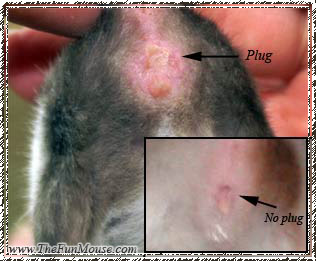
When a buck mates with a doe he will leave behind a vaginal plug as shown in the picture above. This plug is designed to prevent other bucks from mating with the doe. The vaginal plug looks like white mucus. It is a liquid paste form at first, then hardens into place. Sometimes this plug can be seen and sometimes it can not. The plug may be too deep to see. If you are able to see the plug, it can help you know when the buck mated with the doe. However, a plug does not always mean that your doe is pregnant. A plug doesn't confirm pregnancy, it only confirms mating has taken place.
Having a scale to monitor weight can give you a better idea if she is pregnant or not, but it's not 100% effective. Females will often lose a couple/few grams within a day or 2 after mating has taken place, then start rapidly gaining weight the further they get into their pregnancy. However, sometimes mice just gain weight, possibly making you think they are pregnant when they are not. Some mice don't gain much weight at all during pregnancy, making you think they are not pregnant when they actually are. Scales can be a useful tool, but like anything else, they don't insure pregnancy.
All of these tools are useful when breeding. However, none of them are 100% effective. There is no way to know that your mouse is pregnant until she has babies. Some ailments can resemble pregnancy, so even if a mouse looks pregnant it doesn't necessarily mean she is.
It has been reported that a female mouse can abort her babies if she smells another male mouse other than her mate. This is extremely rare with domestic mice. However, studies show that a female mouse will abort and absorb her fetuses anytime after being 2 days pregnant if she smells another male mouse other than her mate. The cause of this is pheromones. These pheromones send off signals to other mice. In this case, it's a male mouse who's telling a female that there might be a better suitor for her. Since she wants her babies to have the best chance at survival, she must mate with the strongest male or the "alpha male." To do this she must abort the litter she is carrying first. It is doubtful that this will happen if there are males in other tanks around the pregnant doe. However, it is very important to never allow another buck near your pregnant doe for this reason as well as knowing the who father is.
Pregnancy

Some pregnant mice look like they swallowed a golf ball while other mice don't look pregnant at all. Some mice look exactly the same from the time they become pregnant to the time they deliver. This is why it is so important to separate the mother from the father before she could possibly have babies. Don't let her size, or lack thereof, fool you. The 2 pictures shown above are of a mouse that has the "I ate a golf ball" look. She is in her last few days of pregnancy. Not all mice look like this. Some are bigger, some are smaller. Some mice look huge when pregnant with very few babies while others with much larger litters might not look pregnant at all. Some mice have small litters with large size babies while other mice have large litters with small size babies. Some mice have average litters with average size babies too. The size of your mouse is not an indication of how many babies she has.
While it is possible to feel the babies in your mouse, do NOT attempt this. You can easily injure the babies and the mother. Killing a baby inside the mother is extremely easy to do. If this happens, it also kills the mother if she isn't able to absorb the fetus. This does not mean that you can't hold her and give her attention though. If the mother isn't looking too uncomfortable and she wants attention, you may absolutely hold her. Let her climb on your hand. Make sure all 4 of her feet are supported by your hand and then lift her up. She will regulate the pressure on her abdomen. Never pick a pregnant mother up by the belly or the tail. Picking up a mother by the tail during her pregnancy can cause the tail to break, fall off entirely, or pull the skin right off. Their tail is not a handle and should not be used as such.
Do note, however, that a mouse with worms can look exactly like a pregnant doe. If this is the case, the worms are severe and immediate vet attention is needed! Additionally, a mouse with a blockage in the digestive system can also look like this as well. Again, if that is the case immediate vet attention is needed. Lastly, some chubby mice can look pregnant. If this is the case a better diet and exercise is needed.
Diet for pregnant and nursing moms
Mice, in general, shouldn't be given high protein and high-fat diets. However, pregnant and nursing moms need additional protein and fat at this critical time. Boosting their diet should start half way through pregnancy and last until after they wean their young. You may boost them before breeding, however, you should never boost them nearly as much as you would a pregnant and nursing doe. Giving a pregnant doe one plain small puppy biscuit (such as Milk Bone Puppy biscuits) once a day works well. Other good things to give them are cooked eggs (scrambled), small pieces of cooked meat, puppy or dog kibbles, and oatmeal. Remember to remove any food that can spoil (such as meat and eggs) within 2 hours after you first offer it. Leaving it out longer can cause food poisoning and death in mice. Always give these things in moderation as well. Giving them too much can do more harm than good! Additionally, if a mouses' diet is suddenly changed it can cause a major digestive upset. This will make her sick and likely cause runny stools. A mouse with runny stools can dehydrate extremely quickly. A dehydrated mouse can die within 24 hours. A few loose stools aren't anything to be too concerned about. This can be caused by a number of things, many of which are not a cause for concern. However, constant runny stools are a large cause of concern. It is best to slowly get your mouse used to these foods. It is also wise to know what types of food your mouse can't handle before breeding and diet-boosting take place. Giving a mouse something new can cause an allergy which is extremely worrisome during pregnancy. Other than this your mouse should be fine on her normal diet prior to getting pregnant, as long as your mouse is on a good staple diet to begin with.Housing pregnant females together
Sometimes keeping to pregnant females together works out great when other times there are devastating results. The upside to having 2 moms together is that they can share the responsibility. Both moms may take an active role in raising the young. IF all goes well, having 2 moms together is a lot easier on them because of how much they can help each other. This is especially true with first-time moms. Having 2 of them together is like having their own support system.However, sometimes theft does happen. Some moms love being a parent so much she will take both litters for herself. At least both moms have milk and can take care of them, unlike theft among nannies. However, depending on litter size, it is doubtful that the mother will produce enough milk to adequately feed both litters by herself. This can cause a weak mother as well as weak babies.
Sometimes abandonment of one litter can happen. Sometimes both moms will not have babies on the same day. If there are more than a couple days in between the births, the younger litter might be abandoned. The mom that had her babies second will see that her babies are a lot smaller than the first litter. She may think that her babies are unhealthy because they are so small. At that point, she may either abandon them or kill them. Nature has a way of weeding out the weak and, in this case, the mom is confused. Even a couple days makes a very noticeable difference in baby size. See the day-by-day baby pictures on this site for reference. If the babies do get abandoned you can try to save them by placing the abandoned litter with the other litter or hand raising the babies. Before merging the 2 litters together you must know that there is a big risk in doing so. It is possible that both moms may abandon both litters or that one or both moms may kill both litters. If you decide to introduce the younger litter to the older litter, take both mothers out of their tank and then place the younger litter at the bottom of the pile of babies. Then put both moms back and leave them alone. If you choose to hand raise the litter, see the Orphan babies section of this site.
When allowing 2 does to have their litters together, it is often unlikely that you will know which babies belong to which mother unless you have a good understanding of mouse genetics and plan the litters extremely well. Surprises often pop up in litters, making it very hard to know which mother the surprise babies belong to if they are birthed together. Extremely careful planning needs to be made to ensure this doesn't happen. You need to know the exact genotype of all parents involved. It is best to breed parents where you are sure what the outcome will be, such as breeding a homozygous agouti parent in one litter (resulting in 100% agouti babies) and breeding 2 nonagouti's for the other litter (resulting in no Agouti babies). However, if you end up with something such as PEW, you will likely not know -for sure- which mother those babies come from. When breeding, it is extremely important to know what babies belong to which parents. This ensures well-tracked lines.
If you choose to take the risk of letting 2 does have litters together, there are some precautions you can take to help the minimize risks. It greatly helps if both does are the same age and in the younger part of their optimal breeding age. This helps ensure that their heat cycles are more regular. House the does together for months before breeding them. This will help get their heat cycles on the same track. Females of any species "pull" each other's heat cycles and they tend to go into heat about the same time. If they go into heat at the same time, they have a better chance of conceiving at the same time, in turn increasing the chances of them having babies at the same time. It also helps to breed both does to the same buck so he can impregnate them around the same time. Different bucks might breed differently. Some (most) bucks are happy to breed as soon as the doe comes into heat. However, some bucks are lazy and it takes them a while to actually breed the doe. Some bucks also have lower sperm counts than others. This can make it harder for one to impregnate a female.
CallaLily- Hero Member

- Join date : 2016-04-03
Posts : 3937

 Caring for Babies: Birth through Weaning
Caring for Babies: Birth through Weaning
Caring for Babies: Birth through Weaning
Breeding is a risk no matter what way you look at it. Everything you do and don't do, has its own risks. Your job as a good caregiver is to educate yourself and take the least amount of risks possible. Evaluate each situation quickly and efficiently. There often is no clear-cut 'right' answer, especially when it comes to things like breeding complications. All you can really do is; 1- Educate yourself so you know how to handle the most amount of situations possible. 2- Know the statistics (odds of a good or bad outcome) resulting from any kind of action you choose to do, or not do. 3- Understand that while it can be hard sometimes, it's best to choose the action (or no action) that is the least risky for a given situation. Taking unnecessary risks is unethical and usually done for selfish reasons. You must place the animals before anything else.End of pregnancy, beginning of birth.
During the end of pregnancy, most does look unmistakably pregnant while some others may look no different in appearance. In the last few days of pregnancy, you may notice that the mother is very uncomfortable, stretches a lot, doesn't move around as much as before, has slightly stressful breathing (not to be confused with labored breathing caused by being ill), etc. In the 24 hours leading to birth, you may even see the mother's belly and sides moving because of her babies moving inside her.It is unlikely you will see her give birth. She should have them in a closed next box, out of your sight. If she has her babies out in the open, it is best to put a towel around her tank to give her enclosed privacy, leaving the top open for good air circulation, and leave the room. As tempting as it is to watch, she NEEDS her privacy at this time for her well-being as well as the babies. The mother and babies have nothing to gain by you watching, and the mother may become upset enough to kill her babies. Never disturb a mouse while she is delivering her babies unless there is an emergency *and* you are positive you can help. Most times the best thing to do is let nature takes its course. Little can be done for a mother in distress and *nothing* should be done without vet consult.
Are they here yet?
First and foremost, after birth, the mother should be left completely alone unless there is an emergency. Bothering the mother before the babies are 3 days old can cause her to kill her babies if she feels threatened (far more likely with skittish mice and untraced lines). Bothering the mother includes lifting the nest box to peak at the babies, even if the mother (and nanny) are not in there. The only thing you should be doing in the 3 days following birth is feeding, watering, and spot cleaning *only when necessary*.Don't worry about not knowing if the babies are born if you can't look. You will know. While some litters are completely silent or only squeak when fighting over nipples, you might find that your litter is extremely vocal. This is completely normal and should not cause you alarm. If you hear squeaking, you know the babies are born and doing fine. Another way to know if mom gave birth is that she will likely spend much of her time in the nest for 24-48 hours after birth. When you do see her out of the nest, she will likely be thinner (losing the 'baby bump'). After the first 1-2 days, mothers tend to spend a lot of time outside the nest, only going back to the nest to feed the babies. If you are using a nanny, she will likely be in the nest far more than mom. Don't be worried that the nanny is stealing the babies unless you hear the nanny fighting with mom and not letting her with the babies at all. It is perfectly normal for the nanny to be very attentive to the babies and mom to only pop in and out to feed.
Postpartum Estrus
A female can come back into heat within hours after giving birth. This is called "postpartum estrus." If a male is with a female when she gives birth, it is extremely likely that he has mated her again. This will result in a back to back pregnancy. The second litter will likely be born before her first litter is fully weaned. The first litter shouldn't be weaned before 28 days, yet the second litter will likely arrive at 20 days. This will usually force the mother to wean her oldest litter faster, which isn't good for their health. Additionally, the second litter will be weaker because of all the stress on the mother. It is shown that babies resulting from a back to back pregnancy will live shorter lives and have far more health problems than babies born to a mother that didn't have a back to back pregnancy.If a male mouse is left in with a female when she has her babies, he may react in a few different ways. He may kill the babies. Male mice have a couple reasons for doing this... If he doesn't recognize the babies as his, he will kill them so he can impregnate the female with his babies. This ensures his genes' survival. He may also kill them because he is jealous. Sometimes a male will kill the babies because he feels that they are taking the mom's attention away from him. It is possible that he will ignore them entirely. This is doubtful but possible. Lastly, he might be the world's greatest dad. Male mice are amazing creatures when it comes to fatherhood. In many species, the male will abandon or kill the babies all of the time. Mice, however, are the opposite. Most of the time a father mouse will be very supportive of the mother and their young, so long as he knows they are his. A male actually has an internal clock of sorts, which will tell him if the babies are his based on conception date and birth date. A male is usually a better "nanny" than a female nanny. However, leaving him in with the mom almost always ensures that the mother will get pregnant again after having her litter. This is very hard on them all and can cause serious health issues, as stated above. A father should never be permitted to live with a mother and babies.
Birthing Complications
- Abandonment
If the mother is having babies all over the tank and they are coming out alive, it is likely that she just doesn't know what to do (if they are coming out dead, see below). If this is the case, don't disturb her. Put a towel or blanket around her tank (but not over the lid of the tank) and leave the room. Hopefully, she will put them in her nest and take care of them. Hand raising should be the very last resort. It is best to give her every opportunity to take care of the babies and not intervene. However, if they are dying from chill (not to be confused with them being stillborn) or she is killing them, fostering or hand raising may be an option. If she is abandoning them, you can try to place her babies in her next box and hope she then accepts them. Doing this is a risk because she already abandoned them once. If you choose to do this, make sure mom is done having babies, remove her from the tank and place her out of sight. Then place the babies into her nest box. Once they are settled, place mom back into the tank (but not into the nest box). Alternatively, you may be able to foster the babies with another mother. If you have another doe with babies the same size as hers, you may choose to foster them with her. See the section on fostering babies in the Caring for Orphan babies section of the site for details on how to best go about fostering and all the risks involved. If a foster mother isn't an option, you may choose to hand rear. However, this has a minimal success rate for babies so young. It is likely that they will all die (older babies have a chance, but for newborn babies, death is very high). Hand rearing will extremely stressful to you as well. You will not sleep for weeks, literally. You will watch many, if not all, of these babies you've come to love die. It is more painful than one can describe. The bond you develop with these babies will be overwhelming and very heartbreaking if they pass. If you hand rear, understand that the babies will need to eat every 1-2 hours. If you can't be with them every 1-2 hours for feeding, you can't hand rear the young. There is no shame in this. Most people are not able to. However, if you can't, don't bother mom -at all-. Let nature take its course. The mother might take care of them, or she may not. But it is up to nature at that point. If the babies by some chance are struggling along hours after she had them, she refuses to take care of them, and there are not other options for the brood, humane euthanasia is in order. - Excessive Blood
Abnormal bleeding means that there is a severe problem. Note that some blood is normal, however, a lot of blood isn't normal. Several pieces of bedding that have blood on it isn't alarming, a lot of blood on many pieces of bedding is not normal, especially if these pieces of bedding are all over the mother's tank. If there is a complication like this you will very likely see abnormal blood outside the nest box. Don't confuse blood from culled babies (babies that the mother has cannibalized) with excessive bleeding. Don't panic and don't bother the mother unless you are sure that she truly is bleeding too much (call your ER vet if you are unsure). The odds of her harming the babies if you invade her nest box are higher than those of her having birthing complications. Therefore, it is better to leave her alone and only worry if you see blood all over the tank. If a mother is bleeding out, she will die in a very short period of time. A vet may be able to help, but it's not likely she will survive even with prompt vet care. If you see this happening you have the same options as the situation below. - Still born
If the babies are all coming out dead, this is a sign of complications. Sometimes a mother will expel her dead babies okay, while other times a baby may get stuck, blocking any births from proceeding. If there is a blockage, it will almost always result in the death of the mother. Death will occur within 24 hours (she will also run a fever, but you will not likely be able to tell). When a mother has an abnormal number of stillborn babies, the chance of a baby not being birthed his higher. Just like above, the odds of her harming the babies if you invade her nest box are higher than those of her having birthing complications. Therefore it is best not to invade the nest to check on her. IF there is a problem you will likely see evidence in the tank without having to invade the nest. If there is a complication, see below. - ER care
If you see your mouse bleeding abnormally or giving birth to dead babies, you have 2 options. You may rush your mouse to a vet for a Cesarean Section, or let nature take its course. If the vet is already going to perform invasive surgery to expel the babies, the mouse should also be spayed. A mouse that has birthing complications may NEVER be bred again. If she is, the chances of repeat complications are extremely high and the pregnancy will likely cost her life. Spaying will also help her live longer, by decreasing her chances of getting different cancers, among other things. However, at the present time, spaying a mouse is just as risky as letting nature take its course. This is provided that you have an experienced vet that has actually spayed a mouse before and has the proper equipment. If your vet does not, then her chances of surviving the surgery are less. It is up to each mouse caregiver to decide which, a caesarean or letting nature take its course, is the better option. As of right now, there is no right answer to this as the risk is the same no matter what you choose.
Cannibalism
Cannibalism is not to be mistaken or treated like a birthing complication (i.e. meaning that you can attempt re-breeding). Sometimes a mother will eat some, or all, of her babies. This is sad but it is a fact of life. There are a few reasons this can happen and some we simply don't know. One reason can be that she lacks a proper diet with adequate protein and fat boosters. Another reason is if she doesn't feel that she can adequately care for them properly due to her own inexperience or being fearful. In these cases, she will cull them as humanely as she knows how (culling quickly is better than alternatives that may hurt more). Additionally, animals know if their babies are healthy or not and a mouse will eat her young if she feels they are not healthy. Many times this will happen to the runt of the litter. If the mother culls a runt or unhealthy offspring keep in mind that nature works in ways that seem strange to us humans but mom mouse does know best. A mother always has a reason to cannibalize and will do what is best for them, even if we never truly know why she culls them. Animals don't like to see suffering, especially their own babies. They would rather take them out of their misery as fast as possible than let them suffer. For instance, if a mother doesn't feel she will have enough milk to feed her babies, she may cull her litter down to compensate for that. Another case where a mother might cull her babies would be if she feels that her babies may be harmed by a predator, including a human. In those cases, she does her best to make death as quick as possible, quicker than a predator likely will. You also have to keep in mind "survival of the fittest." In order for a species to survive, only the strong can live. Unlike humans, animals have a better instinct of which ones are strong. To preserve the species, they will sometimes weed out the less healthy. However, mice are so domesticated that they have lost much of this instinct. You likely would never know why she did it, but mom does. Never doubt that mom knows more than you and never be mad at mom for doing what she feels is right.Sometimes a first-time mom will eat or kill her entire litter. This is commonly known in the fancy as "first-time mom syndrome." No one is positive why this happens (other than the possible reasons given above), though it does happen much more often with untracked lines. If you have a first-time mom who has killed her babies (and shows no signs of complications), don't hesitate to breed her again after she recovers. Keep in mind that a mother that loses her litter needs MORE time to recover than a mother that has a successful litter. Nature is an amazing thing. There are several things working together to help both mother and babies be as healthy as possible. For instance, when babies suckle from mom her uterus contracts, going back into place. This helps her recover faster. If she doesn't have that suckling stimulation, it will take her body longer to recover. You can't see this from the outside. This is only one of many examples proving that mom needs babies almost as much as she needs them. When she is ready to be bred again (if you choose to, and she is able), she will probably be a great mom the second time around despite her first litter.
Cannibalism also happens after a mouse has died. Some people find one of their babies half eaten and assume that the mother killed the baby. This is not necessarily the case. It is possible that the baby was already dead before the cannibalism. Mice are very clean animals. When one mouse dies they feel the need to clean up after him or her. A mouse's way of "disposing" of the body is to eat it. If they don't eat him/her, then they will often bury him/her. A mouse in a tank can't remove the body, so they do what they can to take care of the situation. I know it's hard but try not to let it disturb you if you see it happen. Do, however, remove the carcass.
Runts

Some litters have no runts while others have one or more. The larger the litter, the higher the chance of having runts. Sometimes people never see them because the mom disposes of them before they get the chance. Some runts can live very long happy lives, while many of them pass early on. Mouse moms, like other animals, often (though not always because we have successfully bred 'nature' out of the mouse, unfortunately) know when their baby is not healthy and may choose to do the most humane thing, which is taking their life early on before they suffer later. This is their way of preventing their young from experiencing a harder life or a miserable death. Keep in mind that this is nature's way and "mom knows best." Some runts that make it to weaning may still live shorter lives (this isn't to discount the few that live normal lives though). Some runts have been known to live several months and then un-expectantly pass away for no obvious reason and to no fault of the caregiver. On a newborn or baby is hard to perform a necropsy and actually see anything because of how small the bub is, therefore it is not readily practiced by vets. We can fairly confidently assume that something was underdeveloped or never developed right. For instance, if the heart or lungs are not developed right, then the baby might live for quite a while before it stops, or the mouse might die at birth. If you have a runt that has unexpectantly passed away for seemingly no reason, keep in mind that this kind of thing happens and it's not your fault.
Peanuts
A peanut is around half the size of a runt and will never live past weaning age. Some people (even the most experienced breeders) mistake runts for peanuts, thus they think they can live longer but in reality, they do not. Sometimes it can be hard to tell a runt from a peanut, especially if there are not both in the same litter (like seen in the picture to the right. Click the image to see it larger). Peanuts are very underdeveloped and never thrive. When mom weans the peanut off milk the peanut will always die no matter what one tries to do to help them thrive. They will become very anemic, often shake, become lethargic, etc and waste away. As with runts, some mothers will dispose of peanuts. If mom doesn't cull them it is best that you, as a responsible caregiver, do so in the most humane way possible. It is not fair to the baby to suffer so horribly before they inevitably die.Handling Babies
While taking special precautions, you may hold the babies when they are 3 *full* days old. 3 days after birth is often mistaken for 2 days. However, the day they are born is NOT one full day it is a partial day, thus should not be counted as a full day. Babies are 3 days old when they are 72 hours old, not 48 hours and some change. Holding the babies too young, or not taking the proper precautions, can result in the mother killing or abandoning the litter. Additionally, giving her time to bond with her babies after birth is one of the most beneficial things you can do for their health and well-being. A better-bonded mother that doesn't have disturbances in the first 3 days has a better chance of being a better overall caregiver to her babies. Bothering the nest too soon is not only a risk, but it's very disrespectful to the mother (no matter how much someone 'thinks' they know their mouse). While it is tempting to peek, the best thing you can do for mom is to leave her alone. Doing otherwise is extremely selfish as it only fulfills your personal curiosity and rarely does anything for the mother and babies. The only exception is if there is an obvious complication and you are *truly* able to help (which should always be known before making the decision to intervene). Only a very experienced breeder that knows how to recognize distress situation and is *able* to handle those situations should even attempt to take a risk, and they should only do so when there is a high-risk litter (such as hairless which have trouble lactating).When holding the babies for the first time, take the following precautions:
- Have a play tank ready for the mother and nanny (if a nanny is used). This play tank shouldn't be too large but should contain some toys. It also helps to add some yummy, yet healthy treats to distract them while you are holding the babies. Cheerios are one of many good options.
- Wash your hands extremely well with antibacterial unscented soap.
- Wait for both mother and nanny (if a nanny is used) to leave the nest box. This may take time and patience. However, never go barging into her nest box. That is her safe spot. Intruding in on her nest box while she is in there can make her feel insecure, possibly making her abandon or eat her babies. It is okay to try to coax them out with a yummy treat.
- Move both mother and nanny into the play tank. Make sure they are secure in there and can not see or hear the babies.
- If you wish to rub your hands in clean bedding from the mom's tank so you smell like them, you may do so now. However, it is a myth that mothers will abandon their babies if they smell like a human with clean hands. It is never good, however, to hold them with scented hands (such as scented soaps or lotions). The reason you should never have an artificial scent on your hands is that they have sensitive lungs and skin (from possible residue).
- With warm hands, pick up the babies gently. Hold them as a group and only for short periods when they don't have fur. Pinkies can chill extremely fast. As they get fur, you can hold them longer and individually if you wish.
- Place the babies into the nest exactly how mom had them.
- Fill the mom's food dish, water bottle, and give her the booster food.
- Spot clean the tank if necessary.
- Return mother and nanny to the tank and leave them alone.
- Wash your hands again.
You should always remove the mother and nanny from the tank until the babies are weaned. Not doing so is a risk to the well-being of the babies. It is not unheard of for a mother and/or nanny to attack babies that have been taken from their tank (while mom and nanny are left in their tank) upon being placed back with them. Understand that mice have extremely poor eyesight. Imagine being almost blind and having a bunch of people come running into your home. What would you do if you had small children at home? The instinct of both human and mouse is to defend their babies. Sadly, sometimes it is done by mistake (for instance, more guns in the home kill family members than 'bad guys.' Just the same, mom might mistakenly attack her babies. It's the same thing). If this happens, it isn't the mouse's fault. It's the human's fault for not knowing better. This is a natural instinct to protect the young. It is best, however, never to breed from a mother (or her offspring) if she dos this. Our job as breeders is to breed all 'aggressiveness' out, making mice as docile as possible. This is removing the nature from the mouse.That's a lot of what domestication is.
Cleaning the Nursery
Ideally, the nursery tank should be set up around a week prior to mom giving birth and have the last cleaning 2 days before mom gives birth. After the babies are born you should not bother anything for 3 days, other than to feed and water. In that time, should there be wet/soiled bedding that needs to be removed, quickly and quietly do so but only when necessary. On day 3 you should begin spot cleaning every day. It is easiest and best to do this while mom (and nanny) is in the holding area during the time you handle the babies. You should fully clean the tank (but NOT the nest) when the babies are 1 week old. The nest can be spot cleaned if it really needs it, but otherwise, leave the nest completely alone until the babies are at least 2.5 to 3 weeks old. Some will even wait until the babies are 4 weeks old and weaned. A mother will generally keep her nest very clean, spot cleaning it herself. If at any time the nest is soiled to the point that it becomes a health risk, it obviously needs to be cleaned as the risk of not cleaning it is higher than cleaning it. Use your better judgment here. Try to leave as much of the old bedding in there as you can, while still removing anything soiled. While cleaning the nest, if needed, move the babies to a safe spot that also keeps them warm (but not hot!). Do not place the babies where the mother (or nanny) can see them. Temporarily placing them in a Kritter Keeper with fleece and shredded Kleenex will work.Taming
For the tamest, most loving, and social babies you should hold them at least once a day from the time they are 3-4 days old. Holding them daily also helps ensure they are healthy because you will get to know their personality and growth rate, thus you will know sooner if there is something wrong. Even the most experienced breeder can't catch things sooner than someone that knows their mice well and handles them daily. When it comes to tameness, there is a lot to be said for both nature and nurture. Mice will take after both parents. Even though they don't know their father, his personality traits will be passed on to an extent. Some odd behaviors of bucks can be tracked through lines even though the babies never meet their father. Breeding tame parents greatly helps ensure tame babies. Nurture also plays a large roll. Nurture is the love you give the babies to tame them. The more you handle and love the babies, the tamer and more adjusted they will be. The more they are tamed and the more exposure to humans they have, the easier time they will have going to new homes as well. The more things they are exposed to helps them accept change much easier. Environment also plays a role. If you use a nanny, the babies will pick up on her behavior and the mother's behavior toward you (learned behavior). They will mimic what they see when the adults interact with you. The tamer they are, the tamer the babies will be. If the babies see how much the adults love you, they will not be frightened. Their outside environment (i.e. the room they are in) also plays a part in how tame and accepting they are. Playing a radio in a quiet room will get them used to sounds not native to your home. A radio should be played at a normal level, not too loudly. A radio is also said to reduce cannibalism, per lab observations. Unless there is an extreme circumstance, mothers and babies shouldn't be kept in too quite of an area, or an area with too little traffic. If they are never exposed to these things, they will have a harder time adjusting to new things and taming will take longer. Mice should never be kept in a loud, extremely high traffic area either. Mild noise, mild traffic, and a setting 'normal' to the mother is the most ideal (unless there is a birthing complication).Popcorn Stage (aka Flea Stage)
The popcorn stage is where the babies bounce around, much like popcorn in a popcorn popper. This stage starts around the time their eyes open, give or take a couple days (some reference the babies as 'hoppers' at this stage in their development). At this stage, the babies have no fear of falling, as if they don't grasp the concept that it can hurt them and they are oblivious to what they are doing. They pop for an array of reasons. Everything is very new to them. New sights and sounds can startle them easily, just like a newborn human baby will throw their hands in the air suddenly when they are scared. Some mice will popcorn for seemingly no reason. Some will popcorn when they feel a sudden movement, such as one of their siblings popping or just moving. It is extremely important to hold popcorn babies by the very base of the tail, gently yet firmly. Also hold them over something soft, such as a box filled with something soft like bedding. It is best not to hold popcorn babies over nothing or high up. Should they get away, you will likely never retrieve them. If their eyes are open, don't hold them over their nest box or tank. This is an incentive for them to jump into their home and will only make the stage worse. Make sure you also cup the baby in your hand at all times. Allow room to breathe but not jump out. Pet them and comfort them with a soft voice. Do not hold more than one popcorn baby at once. Doing so only increases the risk of them jumping out of your hands. The popcorn stage lasts for around 1 week, on average. Severe cases can last a couple weeks and if not worked with, they may never become tame. Once they emerge out of the popcorn stage they grow into what can be compared to human child's' terrible 2 stage. This is when they want to explore everything. They are like puppies and have a lot of energy to burn off. They will play a lot. They start growing out of that stage around 5-6 weeks of age.Some mice go through worse popcorn stages than others. Pet shop or poorly bred mice often go through a horrible popcorn stage which can even include biting. Biting is NOT okay. Any mouse that does this should not be allowed to pass their genes on (and you may even consider not breeding the siblings either). Babies that go through a horrible popcorn stage can be very trying to the patience and dangerous to the pups. However, not all mice will go through the popcorn stage at all. Mice from well-bred lines often don't go through a popcorn stage at all. This is one of many drastic differences between pet shop mice and well-bred mice. Well bred mice have the "fright and flight" bred out whereas pet shop and other poorly bred mice still have that instinct well intact. This can lead to not only horrible popcorn stages but a flighty mouse throughout life. Mice that go through a horrible popcorn stage need to be worked with at least once a day, if not 2 times a day. They will never be as tame as well bred mice, but they can be lovely companions if worked with well enough.
Mounting Behavior
It is perfectly normal for siblings to mount other siblings (bucks mounting bucks, bucks mounting does, does mounting bucks, and does mounting does) and mother mounting babies (both bucks and does). This is behavioral, NOT reproductive. If you see this, don't panic. If the babies are under 4 weeks old, no offspring will come of this behavior. Mounting is contributed to a couple of things. In part, it is due to establishing dominance. The one doing the mounting is trying to assert her or himself as more dominant than the one being mounted. When the mother mounts the babies is done sometimes to assert dominance to her ever independent babies and sometimes to show the babies how to mate. While this seems odd to us, think of it like her teaching them about 'the birds and the bees.' Us humans can talk to communicate, whereas animals rely heavily on body language. While it seems odd to us, when you understand that they can't sit down and talk about it, it helps us realize that this really isn't the odd. It's necessary to do it this way as they don't have an alternative. This is actually extremely important behavior and a necessary step in their 'education,' if you will. Studies will reflect that animals weaned too young sometimes never reproduce due to simply not understanding how, or not developing the drive to. This is heavily contributed to their mother never being able to teach them. This is one of many reasons that proves how important it is to leave the mother with her kin until 4 weeks of age.Weaning/Separation
The weaning process begins when the babies open their eyes at 2 weeks (give or take a few days) and will be completed by the time they reach 4 weeks. As their eyes open they will begin to explore and nibble on adult food as well as start tasting the water from mom's bottle. You needn't give the babies anything special to help them onto adult food and you needn't worry about them learning the bottle as mom will teach them by example. As they begin eating adult food, they will decrease their milk intake. They still need to remain with their mother until 4 weeks of age as she is still providing them with necessary milk and teaching them about life. Note that just because you don't see mom nursing it doesn't mean she isn't. You can not possibly watch them 24 hours a day to know exactly what is going on. As the babies grow, the mother will slowly wean them off her milk. They will be fully weaned by 4 weeks. At this point, you MUST separate the bucks from the does. If the bucks are not removed at 4 weeks of age they may impregnate the mother and their sisters. Do not panic when reading that and separate them too early. There is no reason to panic. Those babies need to be with mom until 4 weeks to be as healthy as possible. Separating even a few days early can prove negative (as outlined in the section above), even deadly in extreme cases. Mice can not reproduce until after the 4 week mark (some older), thus separating them on 4 weeks to the day is the safest time frame possible. On the extremely rare occasion that someone has "claimed" that a 4 week old impregnated the mother or siblings most, if not ALL, cases it has been because the caregiver simply didn't keep track of their age well enough (i.e. the litter was actually over 4 weeks of age). There is a risk to both separating before 4 weeks and waiting until after 4 weeks. 4 weeks, to the day, is the safest possible time to separate the bucks. This isn't to say that separating younger will always result in death. That isn't the case and sadly some individuals pull babies too young, not realizing the harm they are doing. The healthiest and most well-rounded babies remain with mom until 4 weeks of age. It is also beneficial (though not 'necessary') to leave the does with their mother for at least an additional week. Breeders have noted increased health and docile nature when practicing this method of caregiving.If your litter is from pet shop lines or anywhere other than well-tracked lines from truly well-educated breeders, it is advisable to separate all of the bucks into their own enclosure at 4 weeks of age. Most bucks will fight anytime beginning shortly after weaning. This is a natural behavior. Bucks in the wild don't interact peacefully with other bucks. If a buck crosses over into his territory they will fight to the death. In captivity, this is true as well. Once their natural hormones kick in they will fight, even with their male siblings. Fighting usually occurs without any notice whatsoever! One day they will be cuddled together sleeping peacefully and the next day one or both will be DEAD or seriously maimed. Please don't take light of this! Time and time again there are cases where people ignorantly leave bucks together because "they are acting fine," they think "it would be cruel to separate them because they get along so well," and "some 'other' sites say bucks can live together" when in reality this is incredibly wrong and completely ignorant of the facts. Sadly there are many ill-informed, though well intended, sites out there. Pet shop lines (and many from great breeders as well!) will kill each other if left together simply because of natural instinct. Leaving them together until they "show signs of fighting" will often result in death as they usually don't show any signs at all. It does, in fact, happen that fast. Additionally, this stands for mice *all over the globe* not just in one region. With that said, some breeders around the world have been able to breed some of the instinct out of them, allowing the bucks to live together. This is more common, though not limited to, countries that have had domesticated mice longer (such as Europe) as they have had more time to breed the instinct out. Unless your mice come from a *good* breeder that *truly* is educated and they have been breeding a line for a substantial amount of time, don't trust that the bucks will live well together. Also, just because there are some (few) breeders out there that have been able to house bucks together it doesn't mean you will. Even lines that have some success being housed together will sometimes have problems, not to mention that bucks that have been breed often can't be housed back in a community. Risking it is NOT worth their lives!! Additionally, a novice should never attempt to allow bucks to live together, no matter the line. Leaving bucks together (with the slim exceptions stated previously) is an unnecessary risk. It is inhumanely playing with their lives. Bucks will have a happy life solo. They will also be better companions to you, as you will then be their only friend. Please don't take that out of context, apply it to all genders, and leave a female alone though. It is cruel to leave a female alone unless there is extenuating circumstance, which is very rare. If you want a single mouse, get a buck. If you want a colony, get does. If you don't have room to house bucks separately, don't breed and don't acquire more than you can handle. There's no good reason to risk their lives by housing them in settings that is not safe or in their best interest.

AppleCheeks- Sr Member

- Join date : 2016-04-03
Posts : 123
 Caring for Orphaned Mice
Caring for Orphaned Mice
Caring for Orphaned Mice
It is VERY important to read ALL of this page if you are going to attempt to foster a mouse with a foster mother or on your own (especially on your own though). I know it looks like a lot, but I can assure you that it is all very critical.Fostering with another mother.
**This section only applies to domestic fancy mice. It's extremely ill-advised to attempt to foster a wild mouse to your fancy doe and her babies.**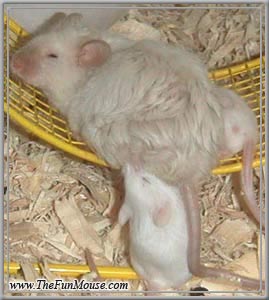
If you have another mouse with babies roughly the same age/size, try to foster the baby (babies) with that mother. Coax the foster mother out of her nest if she is in there at the time of the switch. Put her in a holding area so she can not see what's going on. Rub the foster babies ever so gently with bedding from the foster mothers tank. Make sure that the bedding isn't solid. Soiled bedding can be harmful to babies. Place the new babies among the foster mothers babies. Do not place them all on top, but rather under and in between her babies. Place the mother back in her tank and let her find them on her own. It is very important not to disturb them any more than absolutely necessary. Adding babies to the nest is a huge change for the mother. Disturbing it even more can cause her to abandon them all. Disturbing includes constantly watching what is going on in there. If something bad happens, you will hear squeaks as long as you are in the same room with them. So there is no need to actually watch what is going on.
There are risks to fostering babies. These risks you need to know about before making the decision. Most of the time fostering babies with another mother will go smoothly. However, sometimes it will not. Using a foster mouse mother is less risk than trying to hand feed them if the babies are under 1-1/2 weeks of age.
If you foster a large number of babies, the mother may not have enough milk to go around right away. Her body has to build itself up. If you have to foster a large number of babies with a new mother, you will need to help her feed them all. If you don't, there is a high chance at some losses. To help foster the babies you will need to remove the mother from her babies several times a day. Coax her out of her nest and place her in a holding tank. Feed the babies as you would an orphan mouse (also included in this page). Once you are done feeding the babies, place the mother back in her tank as you would after adding the new babies. You should supplement them for a few days at least. Make sure they are growing well and have milk bellies. When fostering only a couple or a few babies, supplements may not be needed. To know if they are needed or not, check the babies (remove mother first) for milk bellies. A milk belly is a white band that forms around the baby's tummy. This is the milk in their stomach. If milk bellies are present, hand fostering probably isn't necessary unless you notice weight loss. Weight loss can occur extremely rapidly in baby mice.
Risks that can happen when adding new babies to the foster mothers brood include abandonment. The mother might not accept the new additions. The smaller the foster babies, the higher the risk that this might happen. If you are unable to foster the babies yourself, this risk is worth taking as the babies will not survive otherwise. Another risk is that the foster mother might abandon or kill her babies as well as the foster babies. This risk is one that you will have to deeply think about and decide if it's worth taking. It is a very personal decision to make. I have needed to foster babies a few times over the years. I have never had a mother not take care of her babies or the foster babies (or harm them in any way). Mouse moms are very nurturing by nature. However, the risk of abandonment is still there.
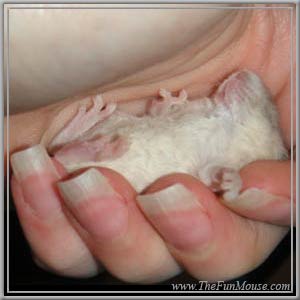
The risks of taking care of new born babies yourself are much higher than trying to foster them with another mouse mother. New born babies need mouse nourishment, something that is hard (if not impossible thus far) to recreate. The chance at a new born baby surviving is much smaller when a person takes care of them rather than if a mouse would. Even if you do everything in your power to take care of them, the chances of survival from a human foster are relatively small. The chances at survival form hand raising do go up significantly as the baby ages. For instance, babies that are 1-1/2 weeks old have a great chance at survival from human fostering.
If you do not have another mouse with babies that can foster the orphan litter, one thing to consider is getting one from your local pet store. Sometimes local pet stores have mice with babies that they might allow you to use. This is also risky for many reasons. You would not only have to take the mother but also her babies. Any time you move a mother with babies there is always a risk that she will abandon them. The same risks of fostering babies with your own mouse mother are also a factor with a pet store mother. There is also the risk of disease that any of the pet shop mice can have. If I was in this position, I would deeply consider fostering with a pet shop mother. The chances at them making it are higher than the chances of your orphan(s) making it if they are hand fed. I would make sure that the pet shop mother looks in good condition first. There are still diseases that can hide and you not know about until later tho. This is also a very personal decision to make, one that only you can make for the better of your mice.
Hand Raising


 . Before you get started, know that this is very time consuming and sometimes no matter how well you take care of the orphan(s) they still may not make it. If that happens and you did your best, rest assured that you did everything possible… it just wasn't meant to be. Also know that you gave that orphan a wonderful life, even if it was a short one.
. Before you get started, know that this is very time consuming and sometimes no matter how well you take care of the orphan(s) they still may not make it. If that happens and you did your best, rest assured that you did everything possible… it just wasn't meant to be. Also know that you gave that orphan a wonderful life, even if it was a short one.When taking care of an orphan mouse you will need some supplies. It is absolutely necessary that these are acquired as fast as possible. The orphan needs nourishment quickly. You will need kitten formula (KMR is recommended). This comes in powder as well as pre-mixed. I prefer powder because it lasts longer. *Unless your formula goes by weight, make sure you dilute it twice the recommended amount.* KMR is designed for kittens (obviously). Pinkies are so much smaller that they can't swallow the KMR unless its diluted more than recommended. You will also need a syringe (no needle) for hand feeding. If the baby is young enough (he/she has eyes still closed) a shoe box with holes in the lid for ventilation will work well. If the baby has its eyes open, a small fish tank, kritter keeper or something else that they can not chew out of is best. Bedding material can consist of clean rags (make sure there are no lose threads that they can get their legs or toes tangled in as his can cut off circulation), paper towels, unscented TP, non-lotion Kleenex, etc. You will also need to keep the baby warm but not to warm! It is just as easy to over heat a baby as it is to not make it warm enough. You can use a heating pad. Turn it on the lowest setting and place it under the tank. It is best to place a towel in between the heating pad and the bottom of the tank. Check it often to make sure it isn't to warm! A mouse nest is around or slightly above 80 degrees F. As the baby gets older (over 2-1/2 weeks) it will be able to maintain its own body temperature easier as long as the room temperature is not to cool. Lastly, you will need Q-tips to stimulate the baby to go potty.
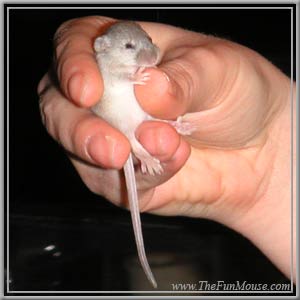
In order to know when/how often to feed the baby, you must first establish its age if it is not known. Try to judge the age using the day by day pictures of mouse babies on my site. Orphan babies are often smaller than babies that have a good mother. Don't let this discourage you when taking care of the baby. The baby might actually be older than what it appears to be. However, take care of it by the age it looks, and not necessarily how old it actually is. For instance, a baby might be 2 weeks old but looks one week old. Take care of it as if it was 1 week old. If your orphan is a new born you will need to feed it every 1-2 hours as a minimum. You must do this around the clock. This will make for many sleepless nights and one of the reasons that taking care of orphan mice is so challenging. If the baby has its eyes open then it is around or over 2 weeks of age. You can decrease feedings some at this point. Every 3-4 hours (weaning gradually) should be sufficient. If the baby at any stage appears to lose weight, try to feed more if the baby is willing. Be sure not to over feed (don't force it). A baby should eat .05cc per gram of their body weight per feeding. This means that a baby of 10 grams should eat .5cc of milk per feeding. Once the baby has its eyes open you can introduce solid mouse food as well as a water bottle. Make sure the bottle is low enough for the baby to reach. It may not drink from the bottle right away. Give it time. I do not recommend water dishes. This can be a huge hazard as the baby can drown in even a small amount of water. Foods you can introduce to a 2 + week old baby are store bought mixes (hamster food is often best), cooked rice (mice generally accept white rice over brown but both are good. White rice often helps them get started as it's more appetizing) mixed with KMR, human baby food (select things that are easy on the digestive track. Stay away from things that might give it the runs, such as spinach, etc), soft kitten food, etc. When the baby is around 3 weeks old it should start to wean itself. Don't worry if it doesn't happen at 3 weeks. Your orphan will come around in his or her own time. It might even be as late as 4+ weeks when it starts to wean. No mouse should be fully weaned before 3-1/2 to 4 weeks of age. Also, orphans usually need to be weaned late. You may feel frustrated or concerned but know that it will happen when the time is right. It's actually quite amazing how it magically happens. Soon enough your baby will be solely on solid foods.
When hand feeding an orphan make sure not to get any formula in its nose!! This is extremely important! If the baby has a nose full of formula it can suffocate easily. Dispense formula in the side of the mouth (as best as you can) using the syringe. Only give it as much as it can eat. Take it slow and don't force it. When first starting to feed an orphan it can prove trying, frustrating, etc. Give it time and keep your patience. After feeding make sure you rub the orphans belly gently with a Q-tip. Try to massage until the baby goes potty. A baby can NOT go potty by itself, you need to assist it. If you do not assist it, it will die from being backed up. Do not rub too hard or irritate the skin. If you have been massaging for a long time and it will not potty, stop for a while and try again later.
Survival rate of hand raised orphan mice depends on age and health. If the mouse shows signs of illness, at any age, the survival rate is low. A new born orphan has a smaller chance at surviving, but don't let that discourage you! I know of many success stories! A baby that has its eyes open has an excellent chance at surviving.
Things will often come up that I did not address here. It is impossible to cover everything. Please refer to the forum for one on one help with your orphan mouse.

AppleCheeks- Sr Member

- Join date : 2016-04-03
Posts : 123
 Housing for Mothers with Babies
Housing for Mothers with Babies
Housing for Mothers with Babies
Ideal housing is very important for the health and comfort of your mother mouse and her babies. This section covers much of what you should know regarding housing and offers an example nursery towards the end.Selecting a nursery tank
After separating your breeding pair, you should put the mother in a nursery tank. It is safest to use a fish tank with a mesh lid (NEVER use a cage with bars of any kind as babies can fit through any bar width). If you intend to use a nanny, now is the time to introduce her to the mother on neutral territory. I find that 10-gallon tanks work best for mothers with babies. You should never use anything smaller than a 10-gallon tank as it is too small. Using a larger tank can work, but mothers often feel less secure in larger areas when they have babies. Keeping track of a dozen+ babies is hard to do and even harder when there is more places the babies could wander off to. If the mother has a litter that is too large for a 10-gallon tank, you can move them all to a larger tank when the babies are 3 weeks old.Food and water accessibility
When setting up the nursery tank you will need to make it adequate to support mother and babies. You also need to make it safe. Make sure they have an adequate water bottle. The bottle needs to be big enough to hold enough water for as many babies as the mother has as well as the mother and nanny, if you use a nanny. The bottle should be placed low enough so the babies can drink from it when they are around 2 weeks old. Never use a water bowl when there are babies around. Babies can easily fall in a water bowl and drown. Babies are extremely clumsy and don't know that water can kill them. They will not be able to get out of a water bowl, no matter how shallow it is. In addition, water bowls are often filthy. Mice tend to bury things, including water bowls. Wet bedding is a breeding ground for bacteria which can cause severe problems for all mice involved. In addition to water, you will need a big enough food bowl to feed all those hungry mouths. Babies eat a LOT of food. Mothers with babies also eat a lot more food than they do when they are not pregnant. Food dishes should also be easily accessible to young babies. A cat food dish often works well for a mouse food dish. It will need to be filled often though.Nest Boxes
The mother will also need a safe place to have her babies. Her nest box should be big enough to fit her, her babies (keeping in mind that the mother could have 25 babies), and the nanny if one is used. The nest box shouldn't be too big though. Mothers need the security of a small and dark place to rear their young. The nest box should be completely enclosed with the exception of a hole for the mother to get in and out of. It is preferred that the entrance hole is a little bit higher than the floor of the tank so that the babies don't easily wonder out before they are ready. However, don't put the hole too high for the mother to easily move in and out. The entrance hole should be 1 inch above the bedding. Newborn babies can easily wiggle out of nests. Sometimes they even hang on to mom's teats when nursing, causing her to pull them out of the nest. The mother will put any stray babies back if they get out, but it is more convenient for her, as well as being safer for the babies, if you take preventative measures to keep them in. Don't leave one side of the nest box open so you can view the babies from the outside. While I understand a persons desire to see the babies, one needs to understand that the mother needs security and should be given her privacy as well as your respect for her space. If a mother doesn't feel secure with her nest box, she could kill her babies! Using a nest box with a pull-off or flip top lid work great. This way you can view the babies without upsetting the mother's nest. Having a flip top box doesn't mean that you can bother them whenever you like though. The mother needs her security and the nest shouldn't be disturbed in any form when the mother is with the babies. Closed bottom boxes are preferred over open bottom boxes. Babies can wiggle under the bottom of a bottomless box and get lost. They can wedge themselves in places that the mother can not get to, such as between the side of the tank and the side of the box. Baby mice can squeeze in really small spaces and get stuck. Babies can get caught between the bottom of the plastic, wood, or other hard surface material used for a nest box and get severely hurt as well. Using a closed bottom box eliminates this risk.Nesting material
When setting up the nest box, give the mother plenty of nesting material. Things like shredded paper, unscented/no aloe kleenex, hay (make sure you freeze or bake any hay before you use it to prevent bug infestations), etc. Cotton of any kind should never be used for babies, nor should it be used with any pocket pet of any age. Cotton can be swallowed and choke pocket pets. It can also get wrapped around the babies toes and limbs causing it cut off circulation. You can use fleece material but stay away from anything with threads as it has the same risk as cotton (cutting off circulation, choking, etc).Toys (including wheels)
A mother and babies can have toys, such as a wheel, cat toy balls, rope (never use cotton. Hemp rope is okay), etc. When picking a wheel, make sure it is safe. Refer to the section of the site about wheels. A mother will be perfectly fine with a wheel when she is pregnant and after she has babies. A safe wheel is not a large danger to her or the babies. Wheels are actually extremely healthy for pregnant mice as well as mothers with babies. An active and physically fit mother will have a much easier time delivering babies and bouncing back from having her litter. A mother will know when to stop running on her wheel. Unless she is a skittish mouse, she will not over do it (skittish mice should never be bred anyway). After a proper diet, exercise is one of the most important things for a mother. It is proven in animals as well as humans that a physically fit and active mother will have healthier babies, be healthier themselves, and will deliver much easier. Sitting on the couch eating bonbons is a thing of the past
Complete nursery example, including pictures.
Below is just an example of a nursery tank to help give you ideas for your own. Yours doesn't have to look like this. This is just what I prefer, after trying many different styles of nest boxes and housing arrangements.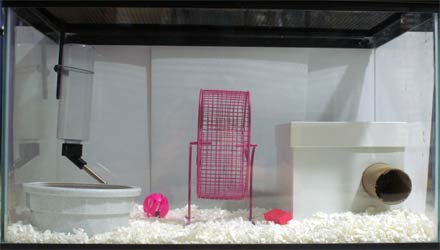
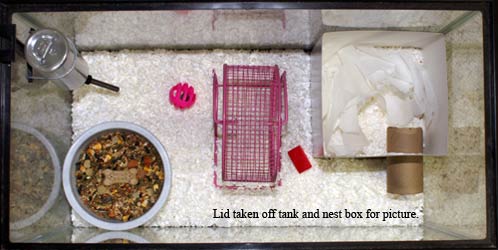
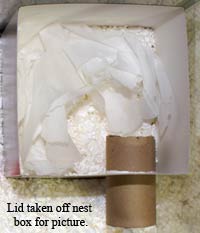
Relocating to a larger tank
As stated above, mother and babies shouldn't be moved before 3 weeks of age. Before relocating, make sure you take the mother and nanny (if a nanny is used) out first and place them in a holding area where they can't see what is going on. Then move the babies *with* their nest into the new tank. It also helps if you use as much stuff from her old tank as possible (food dish, wheel, toys, etc). Once the tank is completely set up, place the mother and nanny in the new tank. After they are moved, leave them alone so they can get comfortable in their new tank.
AppleCheeks- Sr Member

- Join date : 2016-04-03
Posts : 123
 Maternity Nannies
Maternity Nannies
Maternity Nannies
This particular article applies to mice that are from well bred, tracked lines. Whether you use a nanny or not is completely up to you, but do know that it is incredibly risky to use a nanny for mice that did not originate from a reputable breeder. I personally have never once needed to use a nanny, my mice always did perfectly raising their own litters without help.Using a Nanny
A nanny is another doe who helps the mother rear her litter. Her nanny should be introduced to her at least 4 days before she is due. This helps her settle in with her new friend. A mouse nanny can be very helpful to the mom. Nannies will bring food into the moms nest while she's heavily pregnant and can't move well. She will also do so while mom is taking care of her young, such as nursing them. When a mother gives birth, her nanny usually assists in the delivery. As the mother has a baby she will often pass it off to the nanny to clean while she delivers another baby. This is a big help for the mom. A nanny will also help take care of the young when mom needs a break from being with the babies. She will clean them and keep them warm. Nannies often spend far more time with the babies than mom does. Using a nanny takes a lot of stress off mom. It also helps the mother recover much faster than if she was to raise the babies on her own. Having so many babies at a time can be very hard and stressful, which will take a lot out of a mouse. Keeping track of them all, cleaning, feeding, etc is a lot for a little mousie to do alone. Mothers with nannies recover from litters a great deal faster as mothers with no nannies.There is a potential down side to nannies though. On a rare occasion, some nannies have been known to kill the babies. Sometimes they do this on purpose and sometimes they kill them with kindness. The nanny might get jealous and kill the babies. She may feel threatened that the babies will get more attention than her. She feels the need to eliminate the babies for her own gain. There are also some nannies that want the babies all for themselves. In theses cases the nanny takes the babies and doesn't let the mom near them. When this happens the babies eventually starve to death because the nanny doesn't have any milk to give them. Different lines of mice tend to have higher or lower risks for bad nanny behavior. Some lines are extremely good nannies and others have bad tenancies. Selecting a nanny can greatly help eliminate the risks of a bad nanny.
Rarely will a mother and nanny from well bred stock not get along. Additionally, nanny theft or harm to the babies from the nanny is extremely rare with well bred and well tracked lines, so long as nanny selection is done properly. With that said, keeping a nanny in with a mom is a personal choice that only the mouse caregiver can make after hearing both sides of the debate.
Nanny Selection
You should never use more than one nanny. Using more than one nanny greatly increases the risks that something can go horribly wrong, including death of the babies. Adding more factors, such as more mice, can only possibly increase the risk. In no way can using more than one nanny help. Additionally, mom deserves a relaxed environment. More mice adds more commotion, increasing her stress.Using a nanny that has previously helped rear a litter is the safest (repeat nanny). This way you have a much better idea of knowing what to expect from the nanny, be it how she interacts with the mother or how she treats the babies. Like people, some nannies are great with babies and some are not as great. Most nannies are fabulous. However, some (few) nannies will ignore the babies completely because they don't know what to do. Some (few) nannies may also cause problems for the mother and babies. Repeat nannies have a better idea what to do and can help the mother more. If a nanny isn't taking to the babies it is best to remove her from the mothers tank. However, understand that being a first time nanny can be startling to her. It might take her a day or 2 to adjust. If a nanny causes problems for the mother and/or babies, remove her immediately.
A nanny mouse should be between the general breeding age, 3-8 months old. A doe that is too young will only cause more problems for the mother than she is worth. The mother will do more babysitting the young doe than the young doe will actually help her. This only adds to the stress and work for the mother. On the other side, an old doe should never be used either because being a nanny is hard work and can take a lot out of a mouse. Older does should be in retirement, not helping rear young. Rearing babies at an old age can take a lot out of a nanny, quite possibly reducing her life span.
When selecting a nanny, never use a doe that has had babies before. If she has, it greatly increases the risk of her stealing the babies. Previous moms usually have a stronger maternal instinct than virgin does which is what makes her desire to take the babies for her own stronger. If baby theft happens, fighting often occurs. Some mice will literally fight over the babies, playing tug-of-war with them. This results in injured babies and often dead babies. A mother and nanny can actually rip the babies in half by tugging on them.
The nanny you choose should be lower in the pecking order than the mother. This helps insure that mother and nanny will get along and the mother has more control. It also helps reduce the risk of the nanny taking the babies. Using a more dominant nanny is a huge risk to mother and babies. Because it is best to use a nanny lower in the pecking order than the mother, it is best to use a nanny that has previously been housed with the mother so you know which one is more dominant. This also helps insure that introductions will go smoother and they will get along better. A mother should never be stressed when pregnant, including introductions. The most ideal circumstance is using one of the mothers less dominant sisters as her nanny.
When introducing a mother to her nanny, do so in a neutral territory as you would when introducing any mice to another. It is best to hold them together, rubbing their scent on each other. Then place them in a small holding area with plenty of ventilation and room to move around, yet not much else to do other than get to know each other without distractions or things to fight over (such as a wheel, food, treats, etc). Being in a small area helps insure that they will ge along. A small or medium kritter keeper works well. While they are in the holding area, prepare the nesting tank. Do this close to the newly introduced does so you can take action if fighting occurs. Read the section on Housing for mother and babies for ideas on nesting tanks. Once the tank is fully prepared, place mother and nanny in there at the same time. Watch them closely to insure there is no fighting. Small spats that involve mild squeaking and slapping are fine. If the mother and nanny get too upset, it is best to separate them by removing the nanny. Note that mice need to work out their pecking order. This is perfectly normal and needs to take place. It is okay if they don't get along perfectly right away. However, they should never fight, argue constantly, bite for keeps, or rumble (rolling around fighting). If you need to separate mother and nanny, do not introduce another doe to the mother for at least 24 hours. If you try a new nanny, again use good introduction techniques. It is generally not recommended to try more than one nanny as it can be too stressful to the mother. It is also best not to introduce the mother to any other mouse within 3-4 days before she could possibly give birth. At that point it is best to let her rear her young by herself as more introductions closer to birth will increase her stress too much.

AppleCheeks- Sr Member

- Join date : 2016-04-03
Posts : 123
 Day by Day Pictures of Baby Mice
Day by Day Pictures of Baby Mice
Please note that babies should not be handled and the nest should not be disturbed until they are 3 days old (at least). The mother needs security and should be left alone. These pictures were taken for the sole intention to help people identify how old their orphan mouse (mice) is (are). I took a calculated risk by taking pictures of these babies before 3 days of age to help those who have found orphaned mice judge how old their baby is. This page has helped them determine age and in doing so it has helped them care for their mice better. I do NOT recommend holding babies at this age out of the respect for the mother and the risks it can have to the babies. I do not do so in my mousery (when I was breeding) for all their well being. Like I said tho, I did take a calculated risk here (all babies grew up just fine) to save the lives of those orphaned (and so far, it has made a big impact!).
This baby grew up to be the size of the average pet shop mouse, weighing around 28 grams.

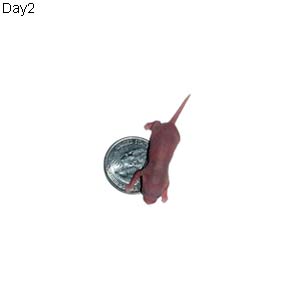
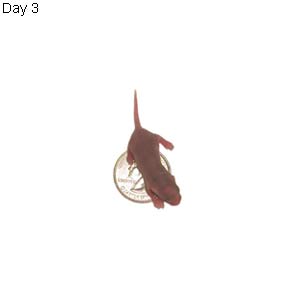



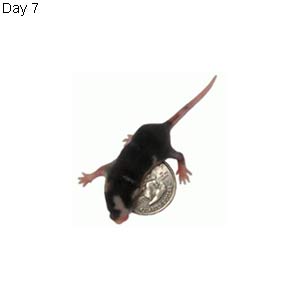
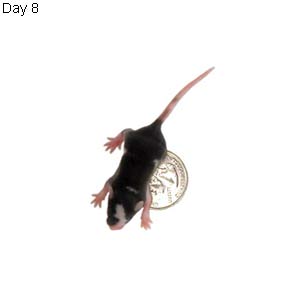

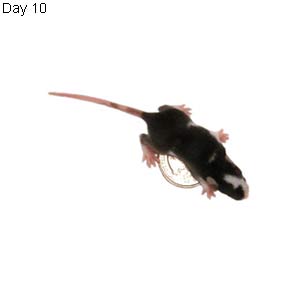
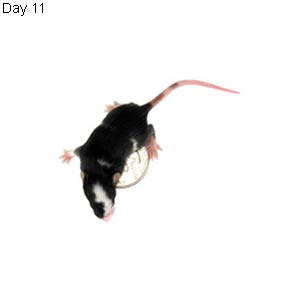
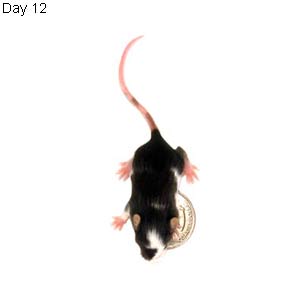
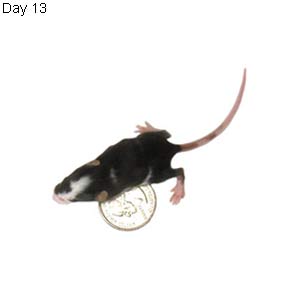


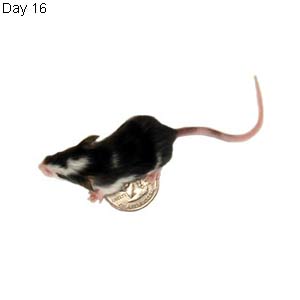


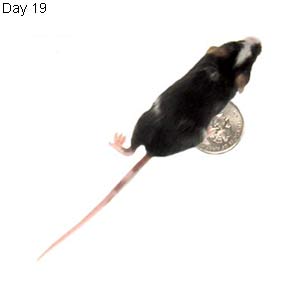
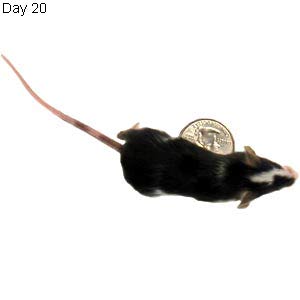


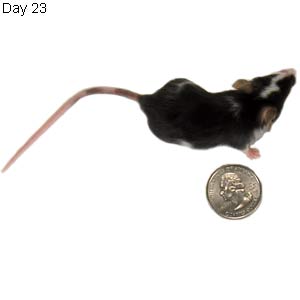
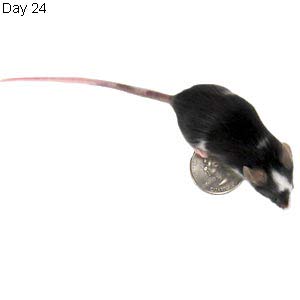
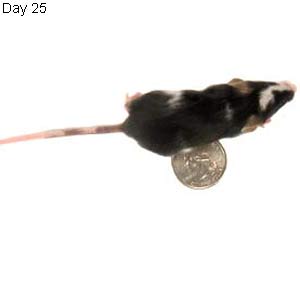
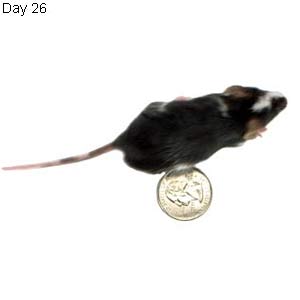
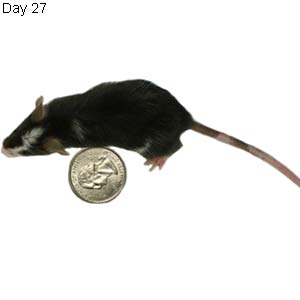
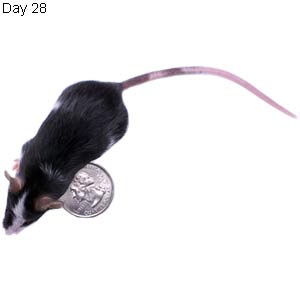
This is Dayna (the mouse in the pics above) as a full grown adult.
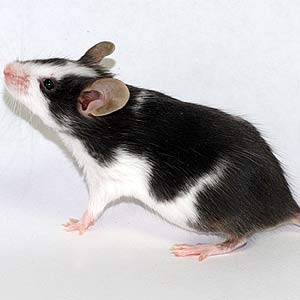
This baby grew up to be the size of the average pet shop mouse, weighing around 28 grams.




























This is Dayna (the mouse in the pics above) as a full grown adult.

CallaLily- Hero Member

- Join date : 2016-04-03
Posts : 3937

 Similar topics
Similar topics» Health Packet
» mouse breeding
» Breeding Pet Store Mice? There's only one way.
» Considering breeding mice
» Howdy! New to breeding
» mouse breeding
» Breeding Pet Store Mice? There's only one way.
» Considering breeding mice
» Howdy! New to breeding
Page 1 of 1
Permissions in this forum:
You cannot reply to topics in this forum










